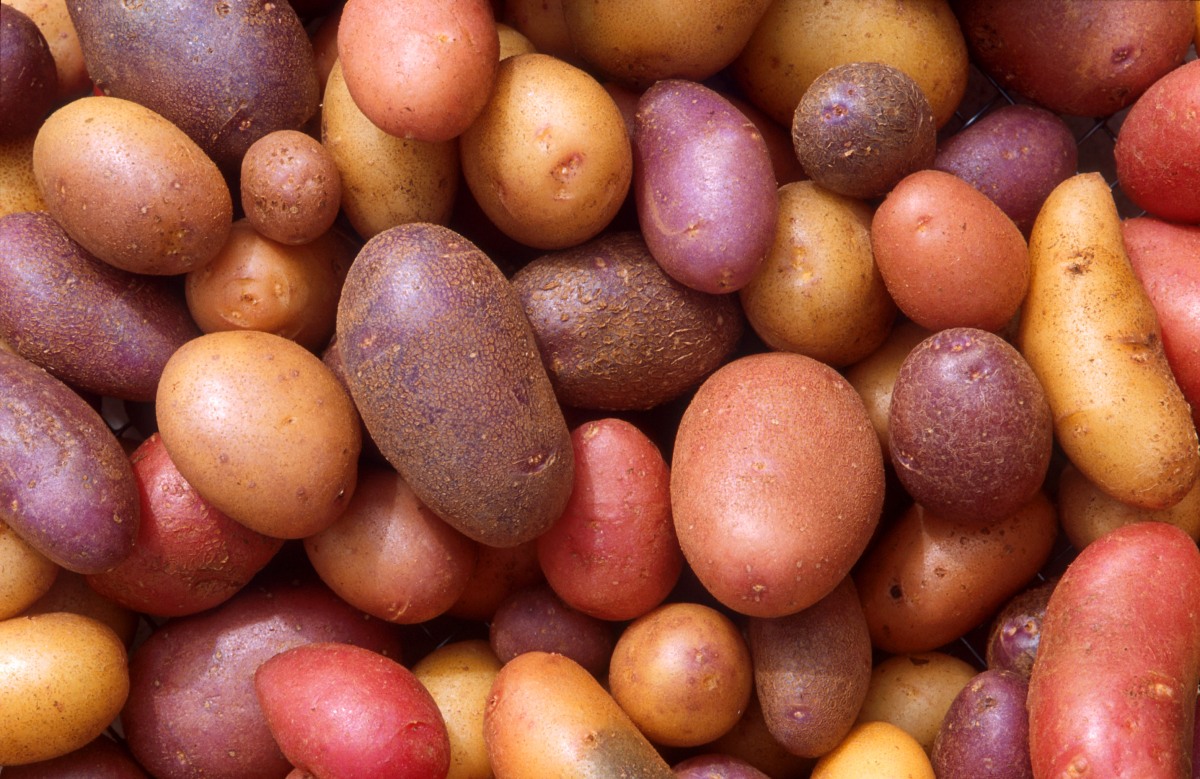Potatoes were first observed by Europeans in 1532 when Pizarro ascended the Andes of northern Peru at Cajamarca several decades after Columbus discovered the West Indies. The first record of cultivated potato outside South America was in the Canary Islands in 1567, and shortly thereafter in continental Spain in 1573. It is believed Spanish sailors in the 1570s brought potatoes back with them across the Atlantic, having introduced them after carrying them in ships’ stores as a foodstuff. Within a decade of its entry into Spain, the crop was introduced to the British Isles.
The origin of the potato in the Canary Islands has long been debated, whether having an “Andean” origin (somewhere from the Andean uplands from Venezuela to northern Argentina) or a lowland south-central “Chilean” origin. Recent molecular evidence documents a wide variation of Andean and Chilean-type cultivars on the Canary Islands, suggesting that there were multiple introductions of both Andean and Chilean germplasm to them.
The late 16th-century herbals of John Gerard, Jean Bauhin, and Carolus Clusius all describe potatoes in northern Europe. Potatoes are known to have been bought regularly at the Seville market from 1580 onwards. In Italy and Germany, there are records that potatoes were cultivated in small gardens by 1601. By 1600, the potato was being grown in Spain, Italy, Austria, Belgium, Holland, France, Switzerland, England, Germany, Portugal, and Ireland. But only to a limited extent. “They were regarded with suspicion as ugly, misshapen tubers and from a heathen civilization … Some felt that the potato plant’s resemblance to plants in the nightshade family hinted that it was the creation of witches or devils” (Chapman, 2000). In Naples as late as 1770, the residents rejected a boatload of potatoes during a famine.
The elite in Europe saw the potato’s potential long before the more superstitious lower classes and greatly encouraged the cultivation of it to feed the masses. In 1771, the French Academy of Besanço offered a prize for a new food that would replace cereals in case of famine. The winner was Antoine-Augustin Parmentier who promoted potatoes, and Louis XVI gave him land to plant them as his prize. In 1744 when a great famine occurred in Prussia, Friedrich the Great ordered the peasants to grow the potato, although the Lutheran and Catholic clerics were against it because it was not mentioned in the Bible. In Sweden, it took a royal edict in 1764 to encourage potato cultivation. In 1850, Nicholas I of Russia ordered the peasants to plant potatoes, establishing its cultivation there. In England, potatoes took off as a crop in 1662 when The Royal Society recommended planting them to prevent famine, and by 1830 potatoes were broadly established as a field crop. English immigrants took potatoes to Ireland and by 1640 it had become an important food crop. The potato became such an important food source in Ireland and the rest of Europe that a potato blight infestation in the 1840s led to about 1 million people starving in Ireland and more than a million fleeing the country.
The Portuguese introduced potatoes, which they called ‘Batata’, to India in the early seventeenth century and cultivated it along the western coast. The first published mention of potato in India is in the travel account of Edward Terry, A Voyage to East-India, where he describes it served in 1675 by the Grand Vizier Asaph Khan to Sir Thomas Roe, the British Ambassador. John Fryer’s travel record (1672-81) mentions potatoes in the gardens of Surat and Karnataka. In the 18th century, the British East India Company gave away a large number of potatoes to peasants to encourage them to produce and eat the crop. However, potatoes did not become a major crop in India until later in the 20th century.
Potatoes were introduced into Indonesia by the late 18th century. The English traveler John Hawkesworth reported in 1770 that he saw both sweet and, as he called them, European potatoes while anchored in Batavia harbor. Between 1785 and 1812 many other observers noted the potato near the cities of Batavia, Semarang, and Surabaya, where they were grown on mountain slopes mainly for European customers. In the first history of Sumatra written by William Marsdenin in the 1780s, he reported that the potato was grown in the Kerinci Valley of Central Sumatra. In the 1840s they were reported in the Padang Highlands on the west coast of Sumatra and, prior to 1860, in the Batak uplands of North Sumatra. In almost all cases, these upland farmers grew them as a cash crop to sell to Europeans.
Potato would also make major inroads into Chinese Agriculture, but not until maize and sweet potato had become well established. The potato didn’t arrive until 1640 in Formosa, and 1700 in mainland China and wasn’t widely distributed until the mid-1800s. Early on, it was important only in cold, mountainous regions. Its wide dispersal didn’t occur until the latter half of the nineteenth century when population increases and a subsequent need to increase food production, coupled with greater peasant mobility, led to its rapid spread.
Illustration: Different potato varieties (USDA)
Bibliography:
Ames, M. and Spooner, D.M. (2008) DNA from herbarium specimens settles a controversy about origins of the European potato. American Journal of Botany 95(2): 252–257
Boomgaard, P. (2003). In the shadow of rice: Roots and tubers in Indonesian history, 1500-1950. Agricultural History 77: 582-610.
Chapman, J. (2000) The impact of the potato. History Magazine. https://www.history-magazine.com/potato.html
Chen, S. and Kung, J.K. (2016) Of maize and men: the effect of a New World crop on population and economic growth in China. Journal of Economic Growth 21:71–99 (Chapman, 2000)
Hancock, J. F. (2022) World Agriculture before and after 1492: Legacy of the Columbian Exchange
Hawkes, J.G., and Francisco-Ortega, J. (1992) The potato in Spain during the late 16th century. Economic Botany 46:86–97
Ríos, D., Ghislain, M., Rodríguez, F. and Spooner, D.M. (2007) What Is the Origin of the European Potato? Evidence from Canary Island Landraces. Crop Science 47:1271-1280
